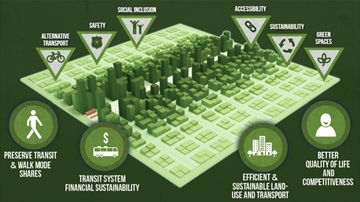From Concept to Reality: Colombia TOD NAMA Moving to Implementation
- Steve Winkelman
- Sep 27, 2016
- 3 min read

The Colombia Transit-Oriented Development (TOD) NAMA, a concept that was conceived in 2011 and preliminarily selected by the NAMA Facility in 2013, will now officially move to implementation, following a €14.7 million grant from the NAMA Facility this past August.
The NAMA is a comprehensive urban strategy that integrates sustainable mobility with land use development, and focuses public and private development around transit stations to create neighborhoods where people can safely walk, live, work, shop and play. TOD has the potential to reduce driving by 30-50%, according to US and Latin American studies, by reducing trip lengths, increasing walking, cycling and transit use and enhancing local and regional accessibility.
Over the past two years CCAP worked on the ground with leading Colombian stakeholders to develop a climate finance proposal for the TOD NAMA. As mentioned in the recent NAMA News article, at the core of this innovative NAMA is the creation of an independent center for the promotion of transit-oriented development (CIUDAT), housed within the national development bank, FINDETER. CIUDAT provides cities with technical and financial assistance on TOD implementation, based on locally-specified needs. CIUDAT also serves a policy advisory role to ensure replication of TOD across Colombian cites and harmonization of policies across ministries.
CCAP collaborated with FINDETER, the Colombian Ministries of Environment, Transportation and Housing, and the National Planning Department to design and launch CIUDAT. Colombia has inaugurated an Executive Board for CIUDAT consisting of senior officials of these 5 national agencies, with CCAP providing advisory input. Technical and policy experts from the six bodies now meet regularly as the advisory committee to CIUDAT to guide NAMA implementation. NAMA development has fostered an unprecedented level of inter-ministerial coordination that sets Colombia on a clear path to sustainable urban development.

The NAMA deploys TOD as a ‘disruptive’ climate technology that transform the landscape of of urban centers, which, in addition to lowering greenhouse gas (GHG) emissions, reduces household transportation costs, expands access to jobs and services and improves social inclusion. The NAMA leverages over $10 billion of Colombian investments in public transport, social housing and GHG mitigation, increasing economic, environmental, and social returns. Through catalytic local projects and national policies for replication, the NAMA is projected to reduce annual GHG emissions by 3.6 to 5.5 MMTCO2 by 2040.

The TOD NAMA will target investment to at least three pilot projects to serve as demonstration cases to catalyze and inform replication of the TOD model across Colombian cities. The CIUDAT team has developed selection criteria and a two-phase process to evaluate city proposals on catalytic TOD projects. For the first phase, preliminary selection considers factors such GHG-reduction potential, replication potential, implementation feasibility and financial leverage. In the second phase, projects will be selected based on factor such as: proximity to high frequency public transport; accessibility to a variety of destinations, including for pedestrians and cyclists; and social equity indicators such as housing affordability. CIUDAT held an initial call for proposals, identifying promising opportunities in Cali, Manizales and Medellín. CIUDAT is proving initial technical assistance on TOD planning to three other cities – Montería, Bucaramanga and Pasto.
With CCAP’s support, Colombia has attracted additional support from the French Agency for Development (AFD). CIUDAT is analyzing “value capture” policy opportunities to direct a portion of increases in land value to support TOD implementation. Over the coming months will CIUDAT hire technical and financial policy staff.
As the technical delivery organization, CCAP will provide guidance to CIUDAT on developing the Measurement & Evaluation plan for the NAMA. Future blog posts will discuss practical and effective approaches for measuring and evaluating the performance and impacts of transformative TOD projects and policies.





شيخ روحاني
رقم شيخ روحاني
الشيخ الروحاني
الشيخ الروحاني
شيخ روحاني سعودي
رقم شيخ روحاني
شيخ روحاني مضمون
Berlinintim
Berlin Intim
جلب الحبيب
https://www.eljnoub.com/
https://hurenberlin.com/